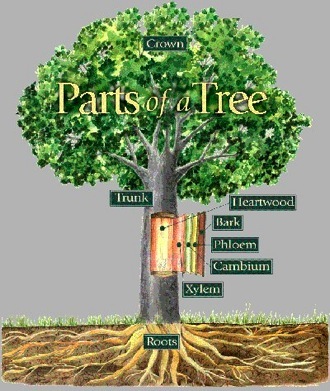
Welcome back to my post. Today, I am going to talk more about plants. To be more specific, "Seed Plants" ! Before I started my post, I headed outside and looked around at the plants in my neighborhood. While I was walking around and looking, I tried to come up with answers to the characteristics of seed plants. I looked, touched and smelled and I noticed things that I never saw before. I wish I could have done some tasting, especially my neighbor's peaches but I did not want to get into trouble.
I saw different stems, roots, leaves and vascular tissue. I saw for the first time "What makes a plant a seed plant?". I saw tall pine trees, apple and pear trees, cedar trees, tulips, lilies, ivy and palm trees and many more. Did you know that there are over 250,000 species of seed plants in the world? Most of the plants around us are seed plants.
Characteristics of Seed Plants
These are the must haves for a plant to be called a seed plant. Pay close attention!, because there are no exceptions to these rules. Here goes my list:
1. Leaves - All seed plants must have leaves. This is the organ of the plant that traps sunlight to make food through photosynthesis.
 |
| Different types of leaves. |
2. Stems - All seed plants must have stems. Stems are the above the ground parts of a plant that support the leaves and flowers. Stems also move nutrients between the roots and the leaves. Stems can be either:
A. Herbaceous - Soft and green like the stems of flowers.
B. Woody - Solid like the trunk of a tree.
 |
| A Woody and Herbaceous stems side by side. |
3. Vascular Tissue - All seed plants must have vascular tissue. This tissue transports food throughout the plant. The vascular tissue of seed plants are:
A. Xylem - Transports nutrients and water up from the roots.
B. Phloem - Moves food from the leaves to other parts of the plant.
C. Cambium - Produces additional xylem and phloem.

4. Roots - All seed plants must have roots. The water and minerals used by the plant enter the plant through the roots. Roots also anchor the plant in the soil and prevent the plant from being blown or washed away. Roots can be:
A. Tap Root - It has a primary root with secondary roots attached and grows deep down into the soil.
B. Fibrous Root - Do not have a primary root and lie close to the surface of the soil.
C. Adventitious Root - Needed to help the plant climb. This is the roots we see in ivies.

5. Seed - All seed plants must have seeds. I know that this one was obvious. These plants produce seeds which are the reproductive part of this plant. Seed producing plants are divided into two groups called Gymnosperms and Angiosperms.
 |
| These are Coconut seeds |
What Are Gymnosperms and Angiosperms?
The major differences between a Gymnosperm and an Angiosperm is that the Gymnosperm do not produce flowers but an Angiosperm do. Also, Angiosperm's seeds are enclosed inside fruit.
The oldest trees in the world today are Gymnosperms. Gymnosperms are vascular plants that produce seeds without an outer fruit. Its seeds are inside cones. Gymnosperms have leaves which are needlelike or scalelike. Examples of Gymnosperms are pine, cedar, juniper and fir trees.
| This a cone on a pine tree. |
Angiosperms plants come in may shapes and colors. They are flowering plants that reproduce from seeds that are in fruits. I found out that all the delicious fruit I love to eat like grapes, strawberries and pears are all Angiosperms. Over half of all plant species in the world are Angiosperms. Examples of Angiosperms are pear, tomato, apple, orange and peach trees.
 |
| A tomato fruit with the seeds on the inside. |
Did you know that Gymnosperms and Angiosperms provide many benefits to us? Gymnosperms plants produce wood used in construction and many paper products we use. It also produces chemicals for soap, paints and medicines. Angiosperms trees take in huge amounts of the carbon dioxide gas during photosynthesis and releases oxygen for us to breathe. They also produce many fibres such as cotton which is used in clothing. Also materials found in Angiosperm plants are used in rubber, oils, perfumes and pesticides.
Monocotyledon and Dicotyledon
We use these two hard to pronounced words when talking about Angiosperm plants. You must be wondering what on earth do these words mean. I almost bit my tongue trying to pronounce these words and still don't know how to say them. But one of the great things about the English language is that we always find a short version for words that are impossible to pronounce. Now, how about Monocots and Dicots? That is much better to pronounce.
I have a clue for you. Remember in Language Arts class we learned about Greek prefixes. The prefix "mono" means one and "di" means two, so we now know that we are talking about numbers here. Also, a cotyledon is something that is inside of a plant seed. It is the first baby leaves that a newborn plant will have. When the seed is planted and it bursts out, the cotyledon will be able to absorb the sunlight and help the plant make its own food to grow the plant. By just looking at a plant you can easily tell whether it is a Monocot or Dicot.
What Makes a Plant a Monocot or a Dicot?
Monocots Characteristics
1. Monocots have seeds that have only one cotyledon.
2. They also have petals in 3s or a multiples of 3.
3. The veins in the leaves are parallel or side by side.
4. There are vascular bundles scattered throughout the plant's stem.

There are about 65,000 types of Monocot species in the world. Examples of Monocots are lilies, palms, onions, asparagus, sweet potatoes and all grasses such as rice, corn and wheat.
 |
| Onion Plants |
 |
| Rice Plants |
Dicots Characteristics
1. Dicots have seeds that have two cotyledons.
2. They have petals in 4s, 5s or a multiples of 4 and 5.
3. The veins in the leaves branch out and then join back together to form net like patterns.
4. There are vascular bundles arranged in the plant's stem like spokes on a wheel .

There are about 170,000 species of Dicot species in the world. Examples of Dicots are poison ivy, cacti, oaks, roses, apples, tomato, grapes, cabbage and pistachios.
 |
| Poison Ivy Plants |
| Cacti Plants |
Thanks for stopping by to read my latest post. I had tons of fun learning and preparing for this post. I am beginning to see plants in a whole different way. I hope that you enjoyed my post and learned something new about plants. Check out my trees jokes.
Q: What kind of tree can fit into your hand?
A: A palm tree!
Q: How do trees get on the internet?
A: They log in.
Come back to visit soon ...........

will i give u a 2.8 because a had to refrwsh the blog a lot of times and u went into textbook mode.
ReplyDeletereally a 3
ReplyDelete